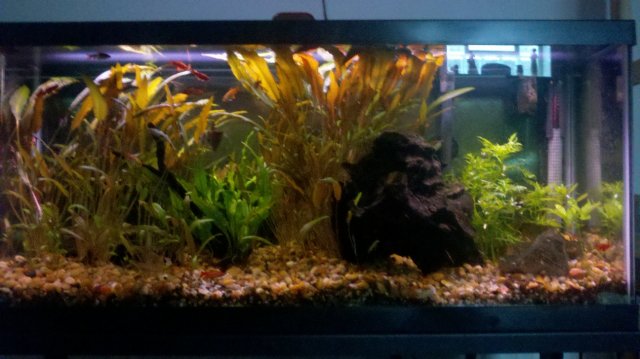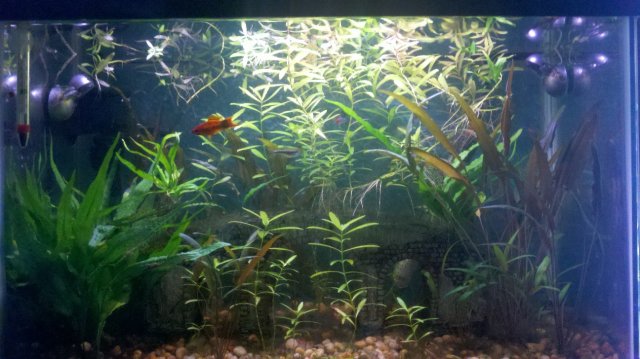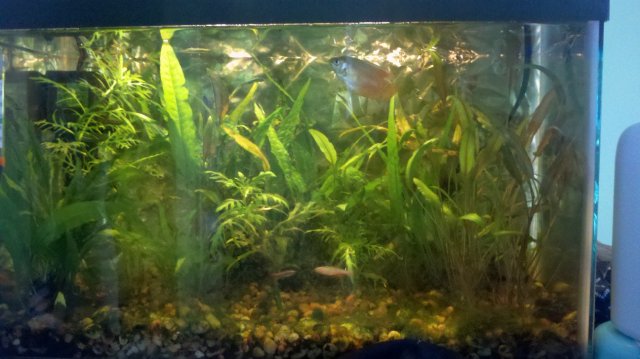Walstad Setup Aquarium.... Pros and Cons? Experience/ Opinions
- Thread starter Eastside Game
- Start date
You are using an out of date browser. It may not display this or other websites correctly.
You should upgrade or use an alternative browser.
You should upgrade or use an alternative browser.
The key to algae control is balance - no matter what methods you are using. You have to control waste (fish stocking) and get the plants to out compete the algae. The other biggie is light. I think a lot of people put themselves in a box. You go to the store to get an aquarium, talk about planted tanks, get told that "plants like light" and end up coming home with a 4x54w T5HO fixture for a 55g tank. At that point you just signed up for ferts 2-3x per week and pressurized CO2, but you may not know that until you start reading about your algae problem!
I changed the water in my 20g for the first time in 6 months last weekend.
I believe that you don't want to go with "just dirt" as a substrate. The best method in my opinion is to put soil down and then put a gravel cap over it. This is discussed in great detail in Diana's book
I changed the water in my 20g for the first time in 6 months last weekend.
I believe that you don't want to go with "just dirt" as a substrate. The best method in my opinion is to put soil down and then put a gravel cap over it. This is discussed in great detail in Diana's book
and that's a great looking tank max
Thanks - I appreciate it.
One other thing on light - Diana Walstad recommends putting tanks in windows with direct sunlight. HERESY!! :jaw:
The first tank is the 30g "semi low tech". The 20g and 10g have soil substrates capped by gravel, no filters and a powerhead to move water.
I have another 30g on the rack below the one in the picture that was my first attempt at a natural aquarium. Miserable failure!! It is empty now, but I will start a new natural tank when I get the time.
Sorry for the quality on the 10g - there is a lot of light in that room and it's hard to get a good shot even with the shades drawn.
Stocking for all of the tanks is in my signature.






I have another 30g on the rack below the one in the picture that was my first attempt at a natural aquarium. Miserable failure!! It is empty now, but I will start a new natural tank when I get the time.
Sorry for the quality on the 10g - there is a lot of light in that room and it's hard to get a good shot even with the shades drawn.
Stocking for all of the tanks is in my signature.






yea i was planning on have soil on bottom capped with eco complete? would that be sufficient? what kind of soil you used and did you add any clay? how many inches of soil and how many inches gravel to cap it?
Eco-complete should be fine. I think I used the Miracle Gro organic for soil and 1.5" of soil covered with about the same amount of gravel. I did not add any clay. My first attempt was just some random topsoil in a bag and it was not a good choice. Read up on the possibility of letting it air out or how long it might take to settle down if you don't. I think if you don't let it air out you can end up with some nasty sulfur smells.
Side note - my 55g has eco-complete and flourite underneath the gravel. I was told by the guru herself this is not the same as soil. On the other hand, there is a lot of mulm down there now.
Side note - my 55g has eco-complete and flourite underneath the gravel. I was told by the guru herself this is not the same as soil. On the other hand, there is a lot of mulm down there now.
One of the things I find most perplexing in this hobby is telling someone to adjust their photo period when it comes to dealing with algae. This was the first thing I was told but during research I came to understand that light is only an issue in a few cases of algae and that algae is more like an equation, similar to that of the fire triangle. Heat+fuel+oxygen=fire. It's just that in this hobby the elements change from one aquarium to the next.
Algae can be birthed by combining two or more of the following:
Phosphates and/or Silicates: Usually blamed on overstocking but can be high out the tap.
Nitrates: End product of the NO2 cycle and directly linked to how much you feed your fish.
Liquid fertz: Even conservative dosing can leave excess ferts in the water column and vice versa
Fluctuating Co2 levels: Determined by temperature of mix and consistency of the diy recipe.
Current/Flow: Ideally you want your plants to sway gently in the aquarium (emphasis on gently) as opposed to "standing still"
Lights: Low, high, kelvin, wpg etc
Plant species and growth rate: This to a lesser extent but can be crucial nonetheless.
In my case the equation worked like this: High phos and silicates + Fluctuating co2 levels+ Low current=Black beard algae
Light had nothing to do with it but as you may have guessed everywhere the advice given was to "adjust your lights." Which lead to a lot of time wasted all while my algae got worse. Just my 2cents...
*EDIT*
I forgot to mention that you can defeat the particular algae simply by removing one element from that algaes equation
op
Algae can be birthed by combining two or more of the following:
Phosphates and/or Silicates: Usually blamed on overstocking but can be high out the tap.
Nitrates: End product of the NO2 cycle and directly linked to how much you feed your fish.
Liquid fertz: Even conservative dosing can leave excess ferts in the water column and vice versa
Fluctuating Co2 levels: Determined by temperature of mix and consistency of the diy recipe.
Current/Flow: Ideally you want your plants to sway gently in the aquarium (emphasis on gently) as opposed to "standing still"
Lights: Low, high, kelvin, wpg etc
Plant species and growth rate: This to a lesser extent but can be crucial nonetheless.
In my case the equation worked like this: High phos and silicates + Fluctuating co2 levels+ Low current=Black beard algae
Light had nothing to do with it but as you may have guessed everywhere the advice given was to "adjust your lights." Which lead to a lot of time wasted all while my algae got worse. Just my 2cents...
*EDIT*
I forgot to mention that you can defeat the particular algae simply by removing one element from that algaes equation
op
Last edited:
not a fan, but i am too used to the consistent maintenance model.
It's all about what keeps the fish keeper happy...
I am going to start up a walstad nano really soon (finally got my 5g hex!) and I will tell you how it goes. This thread seems to have it covered pretty well though.


